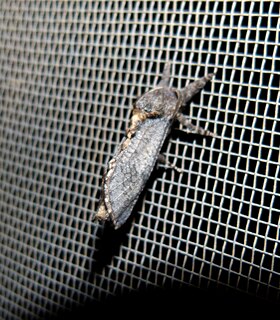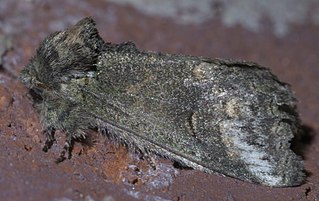
Heterocampa obliqua, the oblique heterocampa or oblique prominent, is a species of moth in the family Notodontidae. It was first described by Alpheus Spring Packard in 1864 and it is found in North America.

Heterocampa astarte, the astarte prominent moth, is a species of moth in the family Notodontidae. It was first described by Edward Doubleday in 1841 and it is found in North America.
Heterocampa ruficornis is a species of moth in the family Notodontidae. It was first described by Harrison Gray Dyar Jr. in 1905 and it is found in North America.
Heterocampa benitensis, the spring snowflake, is a species of moth in the family Notodontidae. It was first described by André Blanchard in 1971 and it is found in North America.

Odontosia elegans, the elegant prominent, is a species of moth in the family Notodontidae. It was first described by Herman Strecker in 1885 and it is found in North America.
Heterocampa amanda is a species of moth in the family Notodontidae. It was first described by William Barnes and Arthur Ward Lindsey in 1921 and it is found in North America.
Heterocampa lunata is a species of moth in the family Notodontidae. It was first described by Henry Edwards in 1884 and it is found in North America.
Sympistis linda is a species of moth in the family Noctuidae. It was first described by William Barnes and James Halliday McDunnough in 1913 and it is found in North America.
Heterocampa astartoides is a species of moth in the family Notodontidae. It was first described by Foster Hendrickson Benjamin in 1932 and it is found in North America.

Heterocampa biundata, the wavy-lined heterocampa, is a species of moth in the family Notodontidae. It was first described by Francis Walker in 1855 and it is found in North America.
Sympistis piffardi, the three-striped oncocnemis, is a species of moth in the family Noctuidae. It is found in North America.
Nacopa melanderi is a species of moth in the family Noctuidae. It was first described by William Barnes and Foster Hendrickson Benjamin in 1927 and it is found in North America.
Heterocampa cubana, the Cuban heterocampa moth or sunflower moth, is a species of moth in the family Notodontidae. It was first described by Augustus Radcliffe Grote in 1866 and it is found in Cuba and the US state of Florida.
Sigela eoides, the youthful sigela moth, is a species of moth in the family Erebidae. It was first described by William Barnes and James Halliday McDunnough in 1913 and it is found in North America.
Heterocampa zayasi, the blue moor-grass moth or zaya heterocampa, is a species of moth in the family Notodontidae. It was first described by Torre and Alayo in 1959 and it is found in Cuba.

Heterocampa subrotata, the small heterocampa, is a species of moth in the family Notodontidae. It was first described by Leon F. Harvey in 1874 and it is found in North America.
Hyparpax perophoroides, the red-lined yellow prominent or lilac moth, is a species of moth in the family Notodontidae. It was first described by Strecker in 1876 and it is found in North America.
Heterocampa belfragei is a species of moth in the family Notodontidae. It was first described by Augustus Radcliffe Grote in 1879 and it is found in North America.

Paectes pygmaea, the pygmy paectes, is a moth in the family Euteliidae. The species was first described by Jacob Hübner in 1818. It is found in North America.
Heterocampa incongrua is a species of moth in the family Notodontidae. It was first described by William Barnes and Foster Hendrickson Benjamin in 1924 and it is found in North America.





